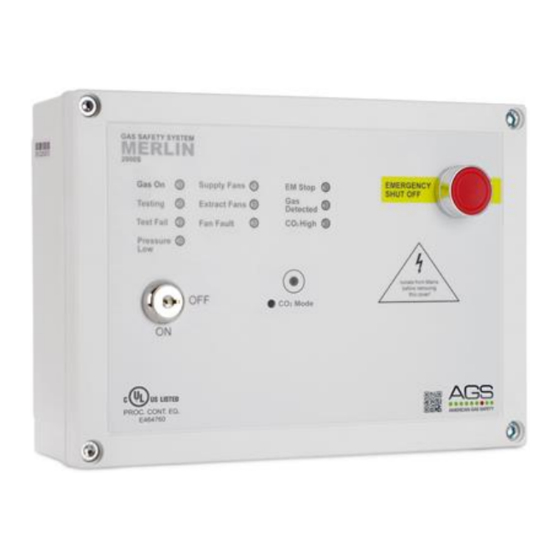AGS Merlin 2000S Руководство по установке и эксплуатации - Страница 11
Просмотреть онлайн или скачать pdf Руководство по установке и эксплуатации для Детекторы газа AGS Merlin 2000S. AGS Merlin 2000S 12 страниц. Gas proving and ventilation interlock system
Также для AGS Merlin 2000S: Руководство пользователя (12 страниц), Руководство по установке и эксплуатации (12 страниц)

Installation & Operation Manual
Maintenance
Cleaning
To keep your control panel in good working order - follow these basic principles;
Remove any dust/debris from the outer enclosure regularly using a slightly damp cloth.
Never spray air fresheners, hair spray, paint or other aerosols near gas detecting devices.
Never paint the device.
It is recommended that any detectors connected to the system are inspected and serviced at least
annually from the date of installation for optimum performance and protection.
Bump Test (Gas Response Check)
What is a Gas Response Check?
Response checks are often referred to as a 'BUMP TEST'. Bump tests are important to make sure a gas
detection device is able to detect a release of gas as early as possible.
The aim of the bump test is to make sure a gas detector is working at its optimum by briefly exposing the
unit to a known concentration of the target gas that exceeds the highest alarm point. If the detector goes
into alarm and all system outputs/relays activate, then it is working safely.
If the system fails to operate as intended in an alarm state, the gas detector must not be used until a full
inspection and service has been conducted.
Why is it important?
A detector may visually appear in good working order, but its sensitivity can be inhibited by external
factors. Dust, humidity, temperature fluctuations, cleaning products, contaminants or sensor drift
(ageing) can cause a decline in sensitivity and eventual failure.
Regular bump tests are important to make sure the detector is able to detect a release of gas as early as
possible.
How often should I Bump Test a detector?
Regular bump tests are important to make sure the detector is able to detect a release of gas as early as
possible. A bump test usually takes seconds (gas type dependant) and is often completed alongside a
scheduled fire alarm test, however the frequency should be determined following a risk assessment by
the end user. Remember, bump testing does not remove the need to have gas detectors inspected,
calibrated and serviced periodically by a trained personnel.
What equipment do I need to perform a Bump Test?
Contact your AGS representative for details of suitable bump testing kits and gases.
Kits usually consist of a certified gas cylinder; flow control regulator, tube pipe and applicator cone.
Rev: 10
02-21
Merlin 2000S
11
